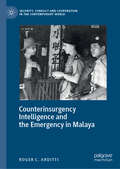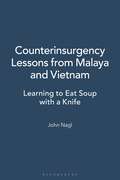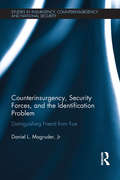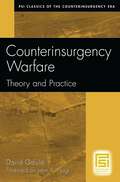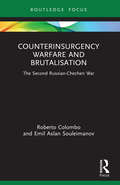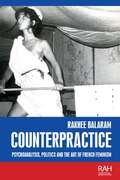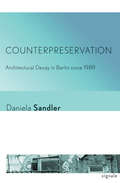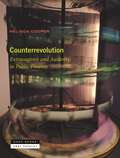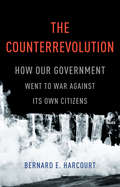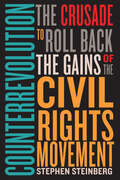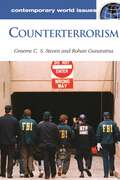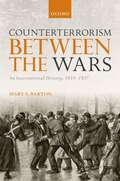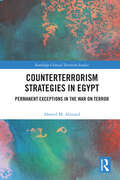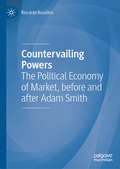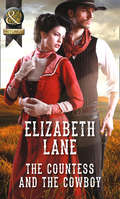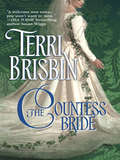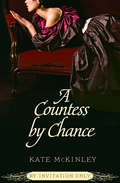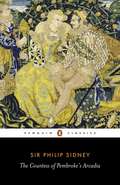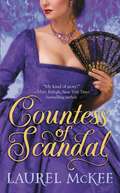- Table View
- List View
Counterinsurgency Intelligence and the Emergency in Malaya (Security, Conflict and Cooperation in the Contemporary World)
by Roger C. ArdittiThis book examines the full range of counterinsurgency intelligence during the Malayan Emergency. It explores the involvement of the Security Service, the Joint Intelligence Committee (Far East), the Malayan Security Service, Special Branch and wider police service, and military intelligence, to examine how British and Malayan authorities tackled the insurgent challenge posed by the Malayan Communist Party. This study assesses the nature of the intelligence apparatus prior to the declaration of emergency in 1948 and considers how officials attempted to reconstruct the intelligence structures in the Far East after the surrender of the Japanese in 1945. These plans were largely based upon the legacy of the Second World War but quickly ran into difficultly because of ill-defined remits and personality clashes. Nevertheless, officials did provide prescient warning of the existential threat posed by the Malayan Communist Party from the earliest days of British reoccupation of Malaya. Once a state of emergency had been declared, officials struggled to find the right combination of methods, strategy and management structures to eliminate the threat posed by the Communist insurgents. This book argues that the development of an effective counterinsurgency intelligence strategy involved many more organisations than just Special Branch. It was a multifaceted, dynamic effort that took far longer and was more problematic than previous accounts suggest. The Emergency remains central to counterinsurgency theory and thus this wide-ranging analysis sheds crucial light not only on the period, but on contemporary doctrine and security practices today.
Counterinsurgency Lessons from Malaya and Vietnam: Learning to Eat Soup with a Knife (Non-ser.)
by John NaglArmies are invariably accused of preparing to fight the last war. Nagl examines how armies learn during the course of conflicts for which they are initially unprepared in organization, training, and mindset. He compares the development of counterinsurgency doctrine and practice in the Malayan Emergency from 1948-1960 with that developed in the Vietnam Conflict from 1950-1975, through use of archival sources and interviews with participants in both conflicts. In examining these two events, he argues that organizational culture is the key variable in determining the success or failure of attempts to adapt to changing circumstances.Differences in organizational culture is the primary reason why the British Army learned to conduct counterinsurgency in Malaya while the American Army failed to learn in Vietnam. The American Army resisted any true attempt to learn how to fight an insurgency during the course of the Vietnam Conflict, preferring to treat the war as a conventional conflict in the tradition of the Korean War or World War II. The British Army, because of its traditional role as a colonial police force and the organizational characteristics that its history and the national culture created, was better able to quickly learn and apply the lessons of counterinsurgency during the course of the Malayan Emergency. This is the first study to apply organizational learning theory to cases in which armies were engaged in actual combat.
Counterinsurgency, Security Forces, and the Identification Problem: Distinguishing Friend From Foe (Studies in Insurgency, Counterinsurgency and National Security)
by Daniel L. Magruder, JrThis book presents a theory and empirical evidence for how security forces can identify militant suspects during counterinsurgency operations. A major oversight on the part of academics and practitioners has been to ignore the critical antecedent issue common to persuasion and coercion counterinsurgency (COIN) approaches: distinguishing friend from foe. This book proposes that the behaviour of security forces influences the likelihood of militant identification during a COIN campaign, and argues that security forces must respect civilian safety in order to create a credible commitment to facilitate collaboration with a population. This distinction is important as conventional wisdom has wrongly assumed that the presence of security forces confers control over terrain or influence over a population. Collaboration between civilian and government actors is the key observable indicator of support in COIN. Paradoxically, this theory accounts for why and how increased risk to government forces in the short term actually improves civilian security in the long run. Counterinsurgency, Security Forces, and the Identification Problem draws on three case studies: the Huk Rebellion in the Philippines post-World War II; Marines Corps’ experiences in Vietnam through the Combined Action Program; and Special Operations activities in Iraq after 2003. For military practitioners, the work illustrates the critical precursor to establishing "security" during counterinsurgency operations. The book also examines the role and limits of modern technology in solving the identification problem. This book will be of interest to students of counterinsurgency, military history, strategic studies, US foreign policy, and security studies in general.
Counterinsurgency, Security Forces, and the Identification Problem: Distinguishing Friend From Foe (Studies in Insurgency, Counterinsurgency and National Security)
by Daniel L. Magruder, JrThis book presents a theory and empirical evidence for how security forces can identify militant suspects during counterinsurgency operations. A major oversight on the part of academics and practitioners has been to ignore the critical antecedent issue common to persuasion and coercion counterinsurgency (COIN) approaches: distinguishing friend from foe. This book proposes that the behaviour of security forces influences the likelihood of militant identification during a COIN campaign, and argues that security forces must respect civilian safety in order to create a credible commitment to facilitate collaboration with a population. This distinction is important as conventional wisdom has wrongly assumed that the presence of security forces confers control over terrain or influence over a population. Collaboration between civilian and government actors is the key observable indicator of support in COIN. Paradoxically, this theory accounts for why and how increased risk to government forces in the short term actually improves civilian security in the long run. Counterinsurgency, Security Forces, and the Identification Problem draws on three case studies: the Huk Rebellion in the Philippines post-World War II; Marines Corps’ experiences in Vietnam through the Combined Action Program; and Special Operations activities in Iraq after 2003. For military practitioners, the work illustrates the critical precursor to establishing "security" during counterinsurgency operations. The book also examines the role and limits of modern technology in solving the identification problem. This book will be of interest to students of counterinsurgency, military history, strategic studies, US foreign policy, and security studies in general.
Counterinsurgency Warfare: Theory and Practice (PSI Classics of the Counterinsurgency Era)
by David GalulaThis volume in the Praeger Security International (PSI) series Classics of the Counterinsurgency Era defines the laws of insurgency and outlines the strategy and tactics to combat such threats. Drawn from the observations of a French officer, David Galula, who witnessed guerrilla warfare on three continents, the book remains relevant today as American policymakers, military analysts, and members of the public look to the counterinsurgency era of the 1960s for lessons to apply to the current situation in Iraq and Afghanistan. With a new foreword by John A. Nagl, author of Counterinsurgency Lessons from Malaya and Vietnam (Praeger, 2002).
Counterinsurgency Warfare and Brutalisation: The Second Russian-Chechen War (Cass Military Studies)
by Roberto Colombo Emil Aslan SouleimanovThis book offers the first analysis of the brutalisation paradigm in counter-insurgency warfare. Minimising the use of force and winning over the population’s opinion is said to be the cornerstone of success in modern counterinsurgency (COIN). Yet, this tells only one side of the story. Drawing upon primary data collected during interviews with eyewitnesses of the Second Russian-Chechen War, as well as from secondary sources, this book is the first to offer a detailed analysis of the long-neglected logic underpinning brutalisation-centred COIN campaigns. It offers a comprehensive systematisation of the brutalisation paradigm and challenges the widespread assumption of brutalisation as an underperforming paradigm of COIN warfare. It shows that, although appalling, brutalisation-centred measures can deliver success. The book also outlines a stigmatised yet widely deployed set of COIN measures and provides critical insights into how Western military blueprints can be improved without compromising important moral and ethical requirements. This book will be of much interest to students of counterinsurgency, military and strategic studies, Russian politics, and International Relations.
Counterinsurgency Warfare and Brutalisation: The Second Russian-Chechen War (Cass Military Studies)
by Roberto Colombo Emil Aslan SouleimanovThis book offers the first analysis of the brutalisation paradigm in counter-insurgency warfare. Minimising the use of force and winning over the population’s opinion is said to be the cornerstone of success in modern counterinsurgency (COIN). Yet, this tells only one side of the story. Drawing upon primary data collected during interviews with eyewitnesses of the Second Russian-Chechen War, as well as from secondary sources, this book is the first to offer a detailed analysis of the long-neglected logic underpinning brutalisation-centred COIN campaigns. It offers a comprehensive systematisation of the brutalisation paradigm and challenges the widespread assumption of brutalisation as an underperforming paradigm of COIN warfare. It shows that, although appalling, brutalisation-centred measures can deliver success. The book also outlines a stigmatised yet widely deployed set of COIN measures and provides critical insights into how Western military blueprints can be improved without compromising important moral and ethical requirements. This book will be of much interest to students of counterinsurgency, military and strategic studies, Russian politics, and International Relations.
Counterpractice: Psychoanalysis, politics and the art of French feminism (Rethinking Art's Histories)
by Rakhee BalaramCounterpractice highlights a generation of women who used art to define a culture of experimental thought and practice during the period of the French women’s movement or Mouvement de Libération des Femmes (1970–81). It considers women’s art in relation to some of the most exciting thinkers to have emerged from the French literature and philosophy of the 1970s – Hélène Cixous, Luce Irigaray and Julia Kristeva – forcing a timely reconsideration of the full spectrum of revolutionary practices by women in the years following the events of May ’68. Lavishly illustrated with over 200 images, the book also features an illuminating foreword by art historian Griselda Pollock.
Counterpractice: Psychoanalysis, politics and the art of French feminism (Rethinking Art's Histories)
by Rakhee BalaramCounterpractice highlights a generation of women who used art to define a culture of experimental thought and practice during the period of the French women’s movement or Mouvement de Libération des Femmes (1970–81). It considers women’s art in relation to some of the most exciting thinkers to have emerged from the French literature and philosophy of the 1970s – Hélène Cixous, Luce Irigaray and Julia Kristeva – forcing a timely reconsideration of the full spectrum of revolutionary practices by women in the years following the events of May ’68. Lavishly illustrated with over 200 images, the book also features an illuminating foreword by art historian Griselda Pollock.
Counterpreservation: Architectural Decay in Berlin since 1989 (Signale: Modern German Letters, Cultures, and Thought)
by Daniela SandlerIn Berlin, decrepit structures do not always denote urban blight. Decayed buildings are incorporated into everyday life as residences, exhibition spaces, shops, offices, and as leisure space. As nodes of public dialogue, they serve as platforms for dissenting views about the future and past of Berlin. In this book, Daniela Sandler introduces the concept of counterpreservation as a way to understand this intentional appropriation of decrepitude. The embrace of decay is a sign of Berlin’s iconoclastic rebelliousness, but it has also been incorporated into the mainstream economy of tourism and development as part of the city’s countercultural cachet. Sandler presents the possibilities and shortcomings of counterpreservation as a dynamic force in Berlin and as a potential concept for other cities. Counterpreservation is part of Berlin’s fabric: in the city’s famed Hausprojekte (living projects) such as the Køpi, Tuntenhaus, and KA 86; in cultural centers such as the Haus Schwarzenberg, the Schokoladen, and the legendary, now defunct Tacheles; in memorials and museums; and even in commerce and residences. The appropriation of ruins is a way of carving out affordable spaces for housing, work, and cultural activities. It is also a visual statement against gentrification, and a complex representation of history, with the marks of different periods—the nineteenth century, World War II, postwar division, unification—on display for all to see. Counterpreservation exemplifies an everyday urbanism in which citizens shape private and public spaces with their own hands, but it also influences more formal designs, such as the Topography of Terror, the Berlin Wall Memorial, and Daniel Libeskind’s unbuilt redevelopment proposal for a site peppered with ruins of Nazi barracks. By featuring these examples, Sandler questions conventional notions of architectural authorship and points toward the value of participatory environments.
Counterrevolution: Extravagance and Austerity in Public Finance
by Melinda CooperA thorough investigation of the current combination of austerity and extravagance that characterizes government spending and central bank monetary policyAt the close of the 1970s, government treasuries and central banks took a vow of perpetual self-restraint. To this day, fiscal authorities fret over soaring public debt burdens, while central bankers wring their hands at the slightest sign of rising wages. As the brief reprieve of coronavirus spending made clear, no departure from government austerity will be tolerated without a corresponding act of penance.Yet we misunderstand the scope of neoliberal public finance if we assume austerity to be its sole setting. Beyond the zero-sum game of direct claims on state budgets lies a realm of indirect government spending that escapes the naked eye. Capital gains are multiply subsidized by a tax system that reserves its greatest rewards for financial asset holders. And for all its airs of haughty asceticism, the Federal Reserve has become adept at facilitating the inflation of asset values while ruthlessly suppressing wages. Neoliberalism is as extravagant as it is austere, and this paradox needs to be grasped if we are to challenge its core modus operandi.Melinda Cooper examines the major schools of thought that have shaped neoliberal common sense around public finance. Focusing, in particular, on Virginia school public choice theory and supply-side economics, she shows how these currents produced distinct but ultimately complementary responses to the capitalist crisis of the 1970s. With its intellectual roots in the conservative Southern Democratic tradition, Virginia school public choice theory espoused an austere doctrine of budget balance. The supply-side movement, by contrast, advocated tax cuts without spending restraint and debt issuance without guilt, in an apparent repudiation of austerity. Yet, for all their differences, the two schools converged around the need to rein in the redistributive uses of public spending. Together, they drove a counterrevolution in public finance that deepened the divide between rich and poor and revived the fortunes of dynastic wealth.Far-reaching as the neoliberal counterrevolution has been, Cooper still identifies a counterfactual history of unrealized possibilities in the capitalist crisis of the 1970s. She concludes by inviting us to rethink the concept of revolution and raises the question: Is another politics of extravagance possible?
Counterrevolution: Extravagance and Austerity in Public Finance
by Melinda CooperA thorough investigation of the current combination of austerity and extravagance that characterizes government spending and central bank monetary policyAt the close of the 1970s, government treasuries and central banks took a vow of perpetual self-restraint. To this day, fiscal authorities fret over soaring public debt burdens, while central bankers wring their hands at the slightest sign of rising wages. As the brief reprieve of coronavirus spending made clear, no departure from government austerity will be tolerated without a corresponding act of penance.Yet we misunderstand the scope of neoliberal public finance if we assume austerity to be its sole setting. Beyond the zero-sum game of direct claims on state budgets lies a realm of indirect government spending that escapes the naked eye. Capital gains are multiply subsidized by a tax system that reserves its greatest rewards for financial asset holders. And for all its airs of haughty asceticism, the Federal Reserve has become adept at facilitating the inflation of asset values while ruthlessly suppressing wages. Neoliberalism is as extravagant as it is austere, and this paradox needs to be grasped if we are to challenge its core modus operandi.Melinda Cooper examines the major schools of thought that have shaped neoliberal common sense around public finance. Focusing, in particular, on Virginia school public choice theory and supply-side economics, she shows how these currents produced distinct but ultimately complementary responses to the capitalist crisis of the 1970s. With its intellectual roots in the conservative Southern Democratic tradition, Virginia school public choice theory espoused an austere doctrine of budget balance. The supply-side movement, by contrast, advocated tax cuts without spending restraint and debt issuance without guilt, in an apparent repudiation of austerity. Yet, for all their differences, the two schools converged around the need to rein in the redistributive uses of public spending. Together, they drove a counterrevolution in public finance that deepened the divide between rich and poor and revived the fortunes of dynastic wealth.Far-reaching as the neoliberal counterrevolution has been, Cooper still identifies a counterfactual history of unrealized possibilities in the capitalist crisis of the 1970s. She concludes by inviting us to rethink the concept of revolution and raises the question: Is another politics of extravagance possible?
The Counterrevolution: How Our Government Went To War Against Its Own Citizens
by Bernard E. HarcourtMilitarized police officers with tanks and drones. Pervasive government surveillance and profiling. Social media that distract and track us. All of these, contends Bernard E. Harcourt, are facets of a new and radical governing paradigm in the United States -- one rooted in the modes of warfare originally developed to suppress anticolonial revolutions and, more recently, to prosecute the war on terror. The Counterrevolution is a penetrating and disturbing account of the rise of counterinsurgency, first as a military strategy but increasingly as a way of ruling ordinary Americans. Harcourt shows how counterinsurgency's principles -- bulk intelligence collection, ruthless targeting of minorities, pacifying propaganda -- have taken hold domestically despite the absence of any radical uprising. This counterrevolution against phantom enemies, he argues, is the tyranny of our age. Seeing it clearly is the first step to resisting it effectively.
Counterrevolution: The Crusade to Roll Back the Gains of the Civil Rights Movement
by Stephen SteinbergIn Black Reconstruction W.E.B. Du Bois wrote, "The slave went free; stood for a brief moment in the sun; then moved back again toward slavery." His words echo across the decades as the civil rights revolution, marked by the passage of landmark civil rights laws in the '60s, has seen those gains steadily and systematically whittled away. As history testifies, revolution nearly always triggers its antithesis: counterrevolution. In this book Steinberg provides an analysis of this backlash, tracing the reverse flow of history that has led to the current national reckoning on race. Steinberg puts counterrevolution into historical and theoretical perspective, exploring the "victim-blaming" and "colorblind" discourses that emerged in the post-segregation era and undermined progress toward racial equality, and led to the gutting of affirmative action. This book reflects Steinberg's long career as a critical race scholar, culminating with his assessment of our current moment and the possibilities for political transformation.
Counterterrorism: A Reference Handbook (Contemporary World Issues)
by Graeme Colin Steven Rohan Kumar GunaratnaAn up-to-date analysis of the wave of terrorism in the post-Cold War era and the ways in which states and societies are responding.Counter-Terrorism: A Reference Handbook outlines the threat of terrorism and ways to combat it. Written by two expert insiders in the field, this extensive examination surveys a wide range of diverse terrorist groups from the Provisional Irish Republican Army (PIRA) to Al Qaeda. It shows how key trends and patterns in domestic and international terrorism such as suicide bombings require counter strategies and tactics including surveillance and reconnaissance.Case studies of terrorist organizations in Europe, Asia, Africa, Latin America, the Balkans, and the Caucasus, and profiles of terrorists like Khalid Sheikh Mohommad, alias Mokhtar (The Brain), who masterminded the Al Qaeda attack on 9/11, illustrate the growing network of groups and leaders harnessing the forces of globalization. Finally, the authors suggest lthat no single state can act effectively on its own to confront terrorism--instead, a wide range of strategies needs to be adopted by all.
Counterterrorism Between the Wars: An International History, 1919-1937 (The Greater War)
by Mary S. BartonMary S. Barton explores counterterrorism in the years between World War I and World War II, starting with the attempted assassination of French Prime Minister George Clemenceau in 1919, and taking the story up to and beyond the double assassination of King Alexander I of Yugoslavia and French Foreign Minister Jean Louis Barthou in 1934. In telling the story of counterterrorism over this period, Barton gives particular emphasis to Britain's attempts to quell revolutionary nationalist movements in India and throughout its empire, and to the Great Powers' combined efforts to counter the activities of the Communist International. Further to this, Barton discusses the establishment of the tools and infrastructure of modern intelligence, including the cooperation between the United Kingdom and United States which would evolve into the Five Eyes intelligence alliance. She gives weight to forgotten terrorism and arms traffic conventions, and explores the facilitating role which the Paris Peace Conference and the League of Nations played in this context. The stories told in Counterterrorism Between the Wars play out across the world, from the remains of the Austro-Hungarian, German, and Russian empires, to the Northwest Frontier and the Bengal Province of British India. A century after the Paris Peace Conference of 1919, Counterterrorism Between the Wars is the first comprehensive study to fit together the mass production of weapons during the Great War with the diplomacy of the interwar era and the rise of state-sponsored terrorism during the 1920s and 1930s.
Counterterrorism Between the Wars: An International History, 1919-1937 (The Greater War)
by Mary S. BartonMary S. Barton explores counterterrorism in the years between World War I and World War II, starting with the attempted assassination of French Prime Minister George Clemenceau in 1919, and taking the story up to and beyond the double assassination of King Alexander I of Yugoslavia and French Foreign Minister Jean Louis Barthou in 1934. In telling the story of counterterrorism over this period, Barton gives particular emphasis to Britain's attempts to quell revolutionary nationalist movements in India and throughout its empire, and to the Great Powers' combined efforts to counter the activities of the Communist International. Further to this, Barton discusses the establishment of the tools and infrastructure of modern intelligence, including the cooperation between the United Kingdom and United States which would evolve into the Five Eyes intelligence alliance. She gives weight to forgotten terrorism and arms traffic conventions, and explores the facilitating role which the Paris Peace Conference and the League of Nations played in this context. The stories told in Counterterrorism Between the Wars play out across the world, from the remains of the Austro-Hungarian, German, and Russian empires, to the Northwest Frontier and the Bengal Province of British India. A century after the Paris Peace Conference of 1919, Counterterrorism Between the Wars is the first comprehensive study to fit together the mass production of weapons during the Great War with the diplomacy of the interwar era and the rise of state-sponsored terrorism during the 1920s and 1930s.
Counterterrorism Strategies in Egypt: Permanent Exceptions in the War on Terror (Routledge Critical Terrorism Studies)
by Ahmed M. AbozaidThis book reveals how counterterrorism discourses and practices became the main tool of a systematic violation of human rights in Egypt after the Arab Uprising. It examines how the civic and democratic uprising in Egypt turned into robust authoritarianism under the pretence of counterterrorism and the ‘war on terror’. By interrogating Egypt’s counterterrorism legislation, the book identifies a correlation between counterterrorism narratives and the systemic violation of human rights. It examines the construction of a national security state that has little tolerance for dissent, political debate or the questioning of official policy, and how the anti-terrorism measures undertaken are actually anti-democracy strategies. The book also traces 150 years of Egyptian counterterrorism and counterinsurgency discourse, and analyses how this links with these practices of human rights assaults. By investigating how this discourse constructs and reproduces knowledge and meaning about terrorism and counterterrorism practices in Egypt, the book highlights how the government legitimises these violations against the population in the interests of the ruling elite. This book will be of much interest to students of terrorism studies, critical terrorism studies, discourse theory, Middle Eastern politics, decoloniality, and International Relations.
Counterterrorism Strategies in Egypt: Permanent Exceptions in the War on Terror (Routledge Critical Terrorism Studies)
by Ahmed M. AbozaidThis book reveals how counterterrorism discourses and practices became the main tool of a systematic violation of human rights in Egypt after the Arab Uprising. It examines how the civic and democratic uprising in Egypt turned into robust authoritarianism under the pretence of counterterrorism and the ‘war on terror’. By interrogating Egypt’s counterterrorism legislation, the book identifies a correlation between counterterrorism narratives and the systemic violation of human rights. It examines the construction of a national security state that has little tolerance for dissent, political debate or the questioning of official policy, and how the anti-terrorism measures undertaken are actually anti-democracy strategies. The book also traces 150 years of Egyptian counterterrorism and counterinsurgency discourse, and analyses how this links with these practices of human rights assaults. By investigating how this discourse constructs and reproduces knowledge and meaning about terrorism and counterterrorism practices in Egypt, the book highlights how the government legitimises these violations against the population in the interests of the ruling elite. This book will be of much interest to students of terrorism studies, critical terrorism studies, discourse theory, Middle Eastern politics, decoloniality, and International Relations.
Countervailing Powers: The Political Economy of Market, before and after Adam Smith
by Riccardo RosolinoThis book will trace the trajectory of the surprising idea that the victims of monopolistic conspiracies should be allowed to fight back using the same fraudulent and immoral weapons as the conspirators. In other words, if left to itself, the market will produce the antibodies necessary to survival, notwithstanding its most sinister pathology – the tendency of its principals to conclude private agreements behind the scenes.Originally conceived in a moral context halfway through the 16th century, the idea was then taken over by the world of commercial law in exactly the form it had been employed theologically. Surprisingly, though, after doing the rounds for over a century, it then disappeared without trace. This book will look at how Adam Smith revived and recharged the idea. He applied it in The Wealth of Nations (1776) to the conflict of interest between employers and workers in the attempt to break the stranglehold of the artificial compression of wages to minimum subsistence level. After Smith, the freshly revived idea went underground again for another half-century until, in the 1820s, it assumed a front-row position in the newborn liberal political economics. This book will look at how, in the framework of the debate over the repeal of the Combination Laws, the idea was dusted down and put back in the fight, having first been stripped it off its moral clothes and dressed instead in the new robes of economic pragmatism.
The Countess and the Cowboy: The Countess And The Cowboy The Rebel Daughter Her Enemy Highlander Winter's Camp (Mills And Boon Historical Ser.)
by Elizabeth LaneA new life in Wyoming! Newly widowed, Eve Townsend is left with a grand title and not a penny to her name. She doesn't know what future she can build in the Wild West…but she's ready to learn, and to reunite with her family.
The Countess Bride: The Debutante's Daring Proposal / The Convenient Felstone Marriage / An Unexpected Countess / Claiming His Highland Bride (a Highland Feuding, Book 4) (Mills And Boon Historical Ser.)
by Terri BrisbinIndulge your fantasies of delicious Regency Rakes, fierce Viking warriors and rugged Highlanders. Be swept away into a world of intense passion, lavish settings and romance that burns brightly through the centuries AS A BRIDE, SHE WAS WORTHLESS
A Countess by Chance (By Invitation Only #2)
by Kate McKinleyThings aren't as proper as they seem in Regency London...The next passionate novella in Kate McKinley's erotic trilogy. A COUNTESS BY CHANCE A gambler's daughter, Sophia Weatherby knows her way around a deck of cards. So when her family estate becomes threatened, she has no choice but to use her skills at the gaming tables to save herself from ruin. A lavish house party affords her the perfect opportunity-until the newly minted Earl of Huntington arrives. Adam Greyson has never forgotten the day Sophia rejected his proposal. Now to even the score, he challenges her to a shocking wager-his two thousand pounds against the one valuable commodity she has left: her virtue.
The Countess of Pembroke's Arcadia: The Original Quarto Edition (1590) In Photographic Facsimile, With A Bibliographical Introduction (classic Reprint) (English Library)
by Philip SidneyBasilus, a foolish old duke, consults an oracle as he imperiously wishes to know the future, but he is less than pleased with what he learns. To escape the oracle's horrific prophecies about his family and kingdom he withdraws into pastoral retreat with his wife and two daughters. When a pair of wandering princes fall in love with the princesses and adopt disguises to gain access to them, all manner of complications, both comic and serious, ensue. Part-pastoral romance, part-heroic epic, Sidney's long narrative work was hugely popular for centuries after its first publication in 1593, inspiring two sequels and countless imitations, and contributing greatly to the development of the novel.
Countess of Scandal (Daughters of Erin #1)
by Laurel McKeeAs children, Eliza Blacknall and William Denton ran wild over the fields of southern Ireland and swore they would be friends forever. Then fate took Will away to England, while Eliza stayed behind to become a proper Irish countess. Years later, Will finally makes his way home-as an English soldier sent to crush the Irish uprising. When he spies the lovely Eliza, he is captivated by the passionate woman she has become. But Eliza's passions have led her to join the Irish rebel cause, and Will and Eliza now find themselves on opposite sides of a dangerous conflict. When Ireland explodes in bloody rebellion, Will's regiment is ordered to the front lines, and he is forced to choose between his duty to the English king and his love for Eliza and their Irish homeland.
